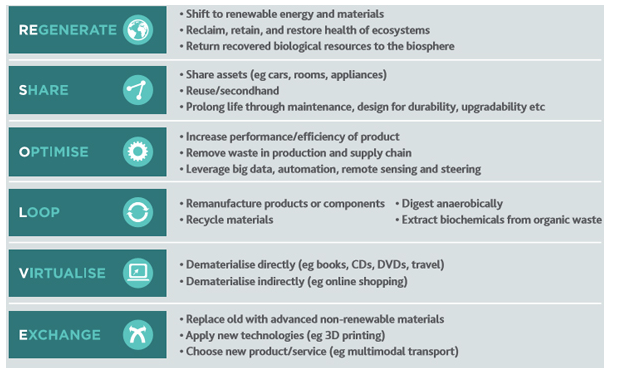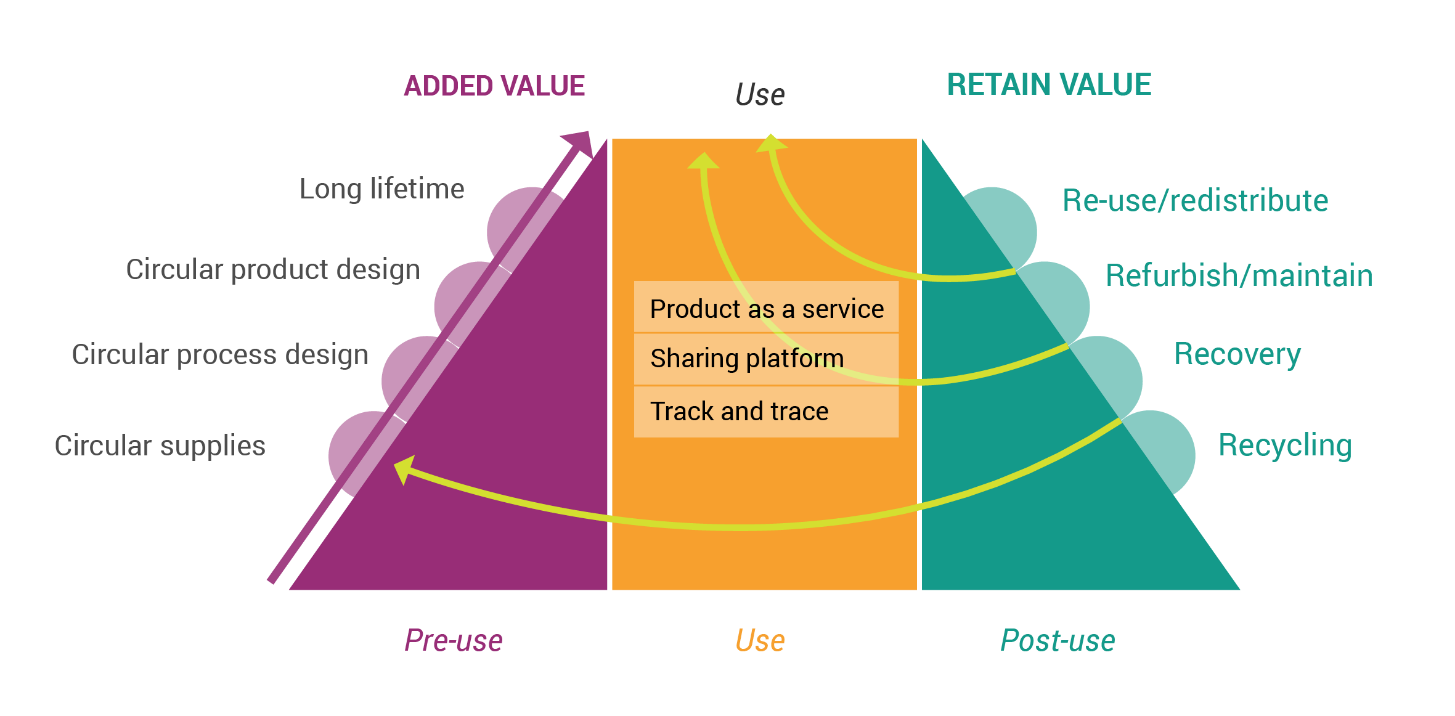Lesson 9 Strategies and business models that help reduce waste in the automotive industry
Strategies and business models that help reduce waste in the automotive industry
The circular economy paradigm focuses on reducing non-renewable materials and energy, promoting renewable raw materials and energy, and keeping products/materials in use throughout the life cycle of a system.
Automobile and component manufacturers are concerned with implementing the circular economy to increase product sustainability.
ReSOLVE
There are different business models applied to circularity, ranging from proposals of different types of models to practices and tools of circular business models [[i]] [[ii]] [[iii]]. Among them is ReSOLVE [[iv]], a business model easy to apply in different organizational contexts, which proposes a set of six fundamental actions (Regeneration, Joint use/shared use, Optimization, Loop, Virtualization, Exchange), on which companies can carry out, as key accelerators of the transition to a circular economy.
ReSOLVE enables companies to establish an overview of the possibilities and map the potential opportunities of the circular economy in all their sectors.

The Value Hill model of the circular economy
To help businesses position themselves in a circular context and develop future strategies for doing business in a circular economy, Sustainable Finance Lab, Circle Economy, Nuovalente, TUDelft, and het Groene Brein got together to create the Value Hill [[v]].
The Value Hill proposes a categorization based on the lifecycle phases of a product: pre-, in- and post-use. This allows businesses to position themselves on the Value Hill and understand possible circular strategies they can implement as well as identify missing partners in their circular network. The Value Hill provides an overview of the circular partners and collaborations essential to the success of a circular value network.
A circular economy combines different processes in the life cycle of a digital device. These processes are interdependent and create new loops within the wider life cycle of a product.

4‑1. Figure_ The Value Hill Model
(Source: The Sustainable Finance Lab, 2016)
The Value Hill model of the circular economy provides an understanding of how to position these processes in terms of value (usefulness) in a circular context.
As shown in Figure above, value increases as the product is developed in the pre-use phase (left uphill slope). The flat top of the hill represents the in-use or use phase of a device when the product’s value is at its maximum. After one cycle of use, the product’s value decreases in the post-use phase (right downhill slope).
Circular choices in each of the processes of the three phases are interrelated. Choices in the uphill phase can contribute to and prolong the use phase, and facilitate a slow descent in the downhill phase.
Reuse, refurbishment and maintenance of a device, facilitated by circular product design, can return devices back to use, or the flat top of the hill.
Finally, the recovery of parts and materials is facilitated by good decisions in the circular design and manufacturing processes.
The circular economy tries to maintain devices as resources with the highest possible value for as long as possible. Inevitably, value can diminish, but regenerative processes can return them to a higher value through refurbishment, repair and maintenance to find and satisfy the needs of a new user, or to a lower value through recovery of components, recycling with recovery of any useful material, or minimising the impact of the unrecoverable fraction (e.g. separate, compact and treat toxic materials to prevent damage).
The Value Hill also provides a practical tool and language to position a business in a circular context and to identify gaps and opportunities to transition to a circular business strategy [[vi]].
[i]Lacy, P.; Long, J.; Spindler, W. The Circular Economy Handbook. Realizing the Circular Advantage; Palgrave Macmillan: London, UK,2020; pp. 39–140.
[ii] Julkovski, D.J.; Sehnem, S. Circular Business Models: An Analytical Perspective. Sustainable Business International Journal, 2021, 1, 1–34.
[iii] Henry, M.; Bauwens, T.; Hekkert, M.; Kirchherr, J. A typology of circular start-ups: An Analysis of 128 circular business models. Journal of Cleaner Production. 2022, 245, 1–21
[iv] McKinsey Center for Business and Environment. The Circular Economy: Moving from Theory to Practice, Special ed.; McKinsey Center for Business and Environment: Munich, Germany, 2016; Volume 1, pp. 1–40.
[v] https://www.circle-economy.com/resources/master-circular-business-with-the-value-hill
[vi] Achterberg, Elisa, Jeroen Hinfelaar, and Nancy M. P. Bocken. 2016. “Master Circular Business with the Value Hill.” White paper. Financing Circular Business. http:// www.circle-economy.com/financing-circular-business